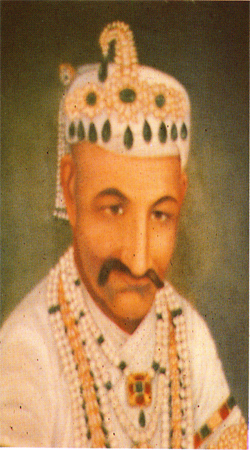|
 He was the son of Raja Govind Baksh and nephew of Raja
Chandulal. Nawab Nasir-ud-Daula Asaf Jah IV appointed him as
Peshkar’ in 1843. However, he resigned as ‘Peshkar’ in 1846. On 12th
September, 1849, the Nizam again appointed him as Peshkar
Subsequently he was appointed as the ‘Diwan’ or Prime Minister on 6th
November, 1849, but he retired a year later on 8th October, 1850 Maharaja Narain Pershad Narainder Bahadur:
He was the son of Bala Pershad and grandson of Raja Chandulal. He was born in 1829. Narainder Bahadur was a scholar in Arabic and Persian and had a good knowledge of English.
He was the son of Raja Govind Baksh and nephew of Raja
Chandulal. Nawab Nasir-ud-Daula Asaf Jah IV appointed him as
Peshkar’ in 1843. However, he resigned as ‘Peshkar’ in 1846. On 12th
September, 1849, the Nizam again appointed him as Peshkar
Subsequently he was appointed as the ‘Diwan’ or Prime Minister on 6th
November, 1849, but he retired a year later on 8th October, 1850 Maharaja Narain Pershad Narainder Bahadur:
He was the son of Bala Pershad and grandson of Raja Chandulal. He was born in 1829. Narainder Bahadur was a scholar in Arabic and Persian and had a good knowledge of English.
His tolerance and sympathy for other religious faiths were admirable. He was Hindu by birth but he adopted the tenets of Sufism in his private life.
When Sir Salar Jung I became the Minister in 1853, he was appointed as ‘Peshkar’ and the Nizam bestowed on him the title of ‘Rajayan Raja’. The title of “Narainder Bahadur” was conferred later.
In 1857, during the Mutiny he played an important role and saved the British Residency from attack. In recognition of his services the British awarded him a silver medal at the Delhi Durbar of 1877.
When Sir Salar Jung I died in 1883, Raja Narainder Bahadur became
the senior administrator of the State with Mir Laiq Au Khan, Salar Jung
II, as the junior administrator. One of the most notable achievements of
Raja Narainder Bahadur was the sanctioning of a railway line from
Secunderabad to Bezwada. (now Vijayawada).
Raja Narainder Bahadur died in 1889 and had only one daughter and Maharaja Kishen Pershad was her son.
|
|